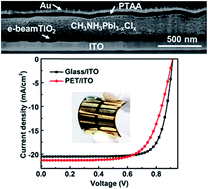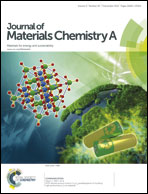An electron beam evaporated TiO2 layer for high efficiency planar perovskite solar cells on flexible polyethylene terephthalate substrates†
Abstract
The TiO2 layer made by electron beam (e-beam) induced evaporation is demonstrated as an electron transport layer (ETL) in high efficiency planar junction perovskite solar cells. The temperature of the substrate and the thickness of the TiO2 layer can be easily controlled with this e-beam induced evaporation method, which enables the usage of different types of substrates. Here, perovskite solar cells based on CH3NH3PbI3−xClx achieve power conversion efficiencies of 14.6% on glass and 13.5% on flexible plastic substrates. The relationship between the TiO2 layer thickness and the perovskite morphology is studied by scanning electron microscopy (SEM), atomic force microscopy (AFM), and X-ray photoelectron spectroscopy (XPS). Our results indicate that the pinholes in the thin TiO2 layer lead to pinholes in the perovskite layer. By optimizing the TiO2 thickness, perovskite layers with substantially increased surface coverage and reduced pinhole areas are fabricated, increasing overall device performance.



 Please wait while we load your content...
Please wait while we load your content...